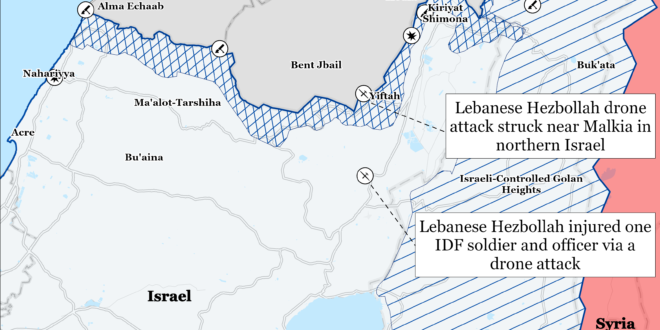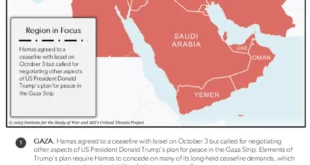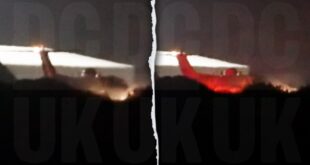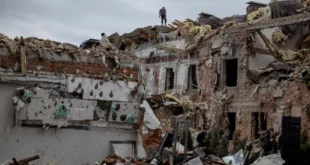Iranian armed forces-run Defa Press published a list of potential civilian and military targets in Israel on August 5, which likely aims to decrease Israel’s ability to effectively defend against an Iranian attack by causing Israel to air- and missile-defense assets and creating panic among civilians.[1] The list includes Israeli military bases and government sites like the Israeli Defense Ministry in Tel Aviv, the Israeli Knesset building in Jerusalem, and eight airbases across Israel. Iran also named civil infrastructure sites like airports, gas fields, and power plants throughout the country.[2] Iran may or may not try to attack any of these targets or others. Iran’s decision to explicitly name these targets, which are spread throughout Israel, likely seeks to cause the Israel Defense Forces to disperse air- and missile- defense assets across a wide area. Iran may calculate that by causing Israel to spread out its defenses, this information effort will increase the likelihood that Iran can hit some of its targets. The US-Israeli coalition intercepted the majority of Iranian drones and missiles outside of Israel during the April 13, 2024 attack on Israel.[3] Drones and missiles fired from Iraq, Lebanon, and Syria would be much harder to intercept than those launched from Iran given the shorter distances and flight times to Israel.
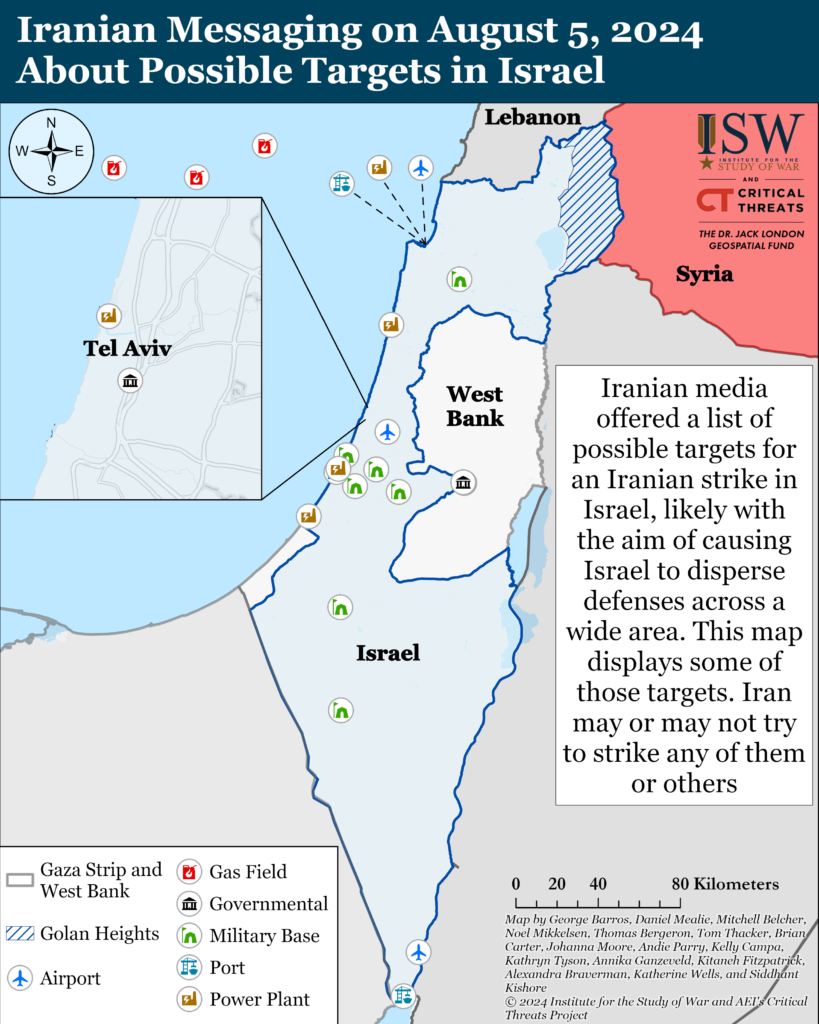
The target list is not necessarily an indicator of what exact targets Iran will strike in response to Israel’s targeted killing of Hamas Political Bureau Chairman Ismail Haniyeh in Tehran. These targets are not all proportionate with Haniyeh’s killing, and publishing some of the targets likely seeks to create informational and economic effects instead of identifying precise targets. Other targets would be significant escalations and seem likely to cause civilian causalities, which Iran would likely calculate is counter-productive to efforts to establish deterrence with Israel.
Government and major military sites: Iran likely included Israeli centers of government—including the HaKirya, Knesset, and Prime Minister’s Office—in the target list anticipating that Israel would then allocate significant defenses to protect those sites. An Iranian attack on the HaKirya—Israel’s equivalent to the Pentagon—would be a substantial escalation on Iran’s part and increase the risk that this retaliatory strike would trigger a major Israeli response that could lead to larger war. A major retaliatory Israeli strike would show that Iran had failed to establish deterrence, which is one of Iran’s very likely goals in responding to Haniyeh’s death. This logic suggests that the inclusion of government and major military sites like the HaKirya is symbolic and informational.
Economic sites: Iran likely included oil and gas fields, airports, shipping ports, and power plants in the target list to generate both economic and informational effects on Israel. A credible Iranian threat to Ben Gurion Airport and Haifa Port would discourage commercial carriers from servicing the sites. A halt to commerce and flights leaving Israel could both foster anxiety amongst the civilian population and advance Iran’s and the Axis of Resistance’s unofficial blockade on Israel. Iran likely understands that an attack on these civilian sites in densely populated areas risks significant civilian casualties and would likely prompt a strong Israeli response. Other targets—such as power plants and oil and gas facilities—are hard to strike in ways that can take them offline for very long, and limited damage to such targets is unlikely to satisfy Iran’s aims. An Iranian attack that aimed to take all Israeli powerplants offline could be inspired and informed by Russian targeting in Ukraine, but Iran and its partners and proxies are unlikely to be able to generate similar effects in Israel. Russian attacks on Ukrainian powerplants have caused significant and protracted damage.[4]
Military sites: Iran likely included Israeli air bases spanning Israeli territory anticipating that Israel would commit additional defenses to the bases, which would limit the IDF’s air defense bandwidth to protect other sites. Iran previously targeted an Israeli airbase in its failed April 2024 attack, making an Iranian targeting of one or several of these bases plausible.[5]
Iran’s identification of targets in Israel does not independently verify CTP-ISW’s assessment of a likely Iranian strike because it is more likely intended to achieve informational effects rather than to specify the precise targets to be struck. Iran’s messaging does align with CTP-ISW’s assessment that Iran and its Axis of Resistance will most likely conduct a coordinated, large-scale drone and missile attack on Israel, however.[6] The operation could involve Lebanese Hezbollah, the Houthis, and Iranian-backed Iraqi militias conducting coordinated strikes on Israel at the same time as Iranian forces. Hezbollah, the Houthis and Iraqi militias have all expressed an intent to attack Israel.[7] CTP-ISW has observed unconfirmed reports that additional groups, such as Iranian-backed militias in Syria and Palestinian fighters in the West Bank may participate in an Iranian-led attack.[8]
[9]
Israel’s security cabinet is discussing preemptive strikes in response to Iranian messaging detailing its planned attack. These details include the participation of Iranian-backed groups throughout the region, including in Syria, Iraq, and the West Bank. Israeli Prime Minister Benjamin Netanyahu reportedly discussed possible “preventative actions or attacks” against Axis of Resistance groups planning attacks on Israel with his security cabinet on August 4.[10] CTP-ISW assesses that Iran will likely coordinate its strikes on Israel with simultaneous attacks from several fronts closer to Israel.[11] Iranian-backed Iraqi militias have reportedly transferred advanced missiles to southern Syria from Iraq in recent days.[12] These missiles could be used in Iran’s attack. Hamas and Iran also reportedly directed Palestinian militias in Tulkarm to conduct an infiltration attack into Israel in the immediate future as part of a response to Israel’s killing of Haniyeh.[13] The IDF conducted preemptive strikes in Tulkarm on August 3, which killed nine Palestinian fighters and destroyed the militia cell responsible for planning the infiltration attack.[14]
Western sources and regional notices to airmen (NOTAM) suggest that an Iranian attack on Israel may occur in the next day. The Biden Administration reportedly told members of Congress on August 5 that an Iranian strike may occur as soon as August 5 or 6.[15] US Secretary of State Antony Blinken separately told counterparts at the G7 on August 4 that Iran might begin its attack in the next two to three days.[16] Iranian authorities issued a NOTAM for the center, west, and northwest of the country, warning of likely disruption to GPS and navigational signals.[17] Iran issued a similar warning on April 13 when it conducted its first direct large-scale missile and drone attack on Israel.[18] Jordanian authorities also issued a NOTAM, effective until Tuesday at 22:00 GMT, requesting all airlines in Jordan to carry 45 minutes of reserve fuel for “operational reasons.”[19] Iran and the Axis of Resistance have a shrinking window of opportunity to attack Israel before the United States completes the transfer of additional military assets to the Middle East. The United States is reportedly sending a carrier strike group, naval cruisers and destroyers, and a squadron of fighter jets to the Middle East in preparation for an Iranian-led attack on Israel.[20] The arrival of these assets to the region would improve the ability of the United States to respond to an Iranian attack, which Iranian leaders almost certainly recognize.
The IDF has deployed additional forces near Israeli communities adjacent to Tulkarm after receiving a credible threat that Hamas and other Palestinian militias may conduct an October 7-like infiltration operation into Israel from the West Bank.[21] An Israeli military correspondent for Israeli Army Radio reported that the IDF has deployed additional troops from the IDF Home Front Command and the IDF 41st Infantry Battalion to “immediately strengthen” the defense of the Israeli communities in the Sharon Plain, bordering Tulkarm, West Bank. The troop deployment comes after Shin Bet received a warning that Hamas and Iran have directed Palestinian militias in Tulkarm planned to conduct an infiltration attack into Israel in the immediate term in response to a series of Israeli strikes that killed senior Axis of Resistance officials in recent days.[22] The military correspondent claimed that the Shin Bet assessed that there was an ”imminent threat” of an attack, prompting the IDF to conduct preemptive strikes in Tulkarm on August 3, which killed nine Palestinian fighters and destroyed the militia cell responsible for planning the infiltration attack.[23] The additional troops deployed across the border areas will act as a quick reaction force in the event of an attack into Israel from the West Bank.[24] Unspecified Israeli security officials claimed that Iran and Hamas are trying to draw Israel’s attention to the West Bank and prevent the Israelis from conducting an operation targeting Lebanese Hezbollah in Lebanon.[25]
Iran and Russia are continuing to promote increased cooperation ahead of the Iranian retaliatory strike against Israel. Russian Security Council Secretary Sergei Shoigu met with various high-ranking Iranian officials in Tehran on August 5.[26] Iranian Supreme National Security Council Secretary Ali Akbar Ahmadian invited Shoigu to visit Tehran in a phone call in May 2024.[27] Shoigu’s visit may have been prearranged prior to Haniyeh’s death, but senior Iranian and Russian officials would have still needed to deliberately decide to go forward with the visit in the context of the current heightened regional tension. It is notable in this context that Shoigu told Iranian officials that Russia is ready for ”all-around cooperation” with Iran in regional affairs.[28] Official Iranian readouts reported that Shoigu expressed a desire to increase political and economic relations in a meeting with Iranian President Masoud Pezeshkian.[29] Pezeshkian condemned the killing of former Hamas Political Bureau Chairman Ismail Haniyeh. Pezeshkian stated that Iran will ”receive answers” for this crime but that ”[Iran] is not seeking to expand the scope of this crisis in the region.” Shoigu separately met with Armed Forces General Staff Chief Major General Mohammad Bagheri. Shoigu and Bagheri discussed increasing bilateral defense and military issues.[30] Shoigu condemned Haniyeh’s killing in Tehran and stated that whoever is responsible aimed to escalate regional tensions.[31]
Shoigu likely also sought to coordinate with Iranian officials ahead of the strike given the implications an Iranian strike launched in part from Lebanon and Syria could have for Russian forces in Syria.[32] Russia has military facilities at Khmeimim, in western Syria and maintains some military police forces in southwestern Syria.[33] Shoigu is expected to hold an additional meeting with Iranian Supreme National Security Council Secretary Ali Akbar Ahmadian on August 5.[34]
Iranian President Masoud Pezeshkian met with Jordanian Foreign Minister Ayman Safadi in Tehran on August 4.[35] Pezeshkian stated that Israel made a ”big mistake” by killing Ismail Haniyeh in Tehran on July 31. Safadi stated that the killing of Haniyeh was an attempt by Israeli Prime Minister Benjamin Netanyahu to ”expand the scope” of regional conflicts. Pezeshkian expressed hope that Jordan and Iran could improve diplomatic relations. Jordan indicated that it may also shoot down projectiles that enter Jordanian airspace, like it did on April 13, should Iran and the Axis of Resistance launch another attack on Israel.[36] Safadi previously stated that Jordan will ”face” anyone who violates Jordanian airspace. Safadi also previously stated that Jordan ”will not become a battlefield.” CTP-ISW previously reported on August 4 that Safadi travelled to Tehran reportedly as part of a last-ditch effort to dissuade Iran from attacking Israel.[37] This marks the first visit of a senior Jordanian official to Iran in 20 years.[38]
US Central Command (CENTCOM) Commander General Michael Kurilla met with Israeli Chief of Staff Lieutenant General Herzi Halevi and Defense Minister Yoav Gallant on August 5 to finalize US-Israeli defense coordination ahead of Iran’s and Iranian-backed groups’ attack on Israel.[39] The IDF reported that Kurilla and Halevi discussed joint defense preparations in the region.[40] Israeli media reported that Gallant and Kurilla discussed expanding the international coalition facing ”aggressive activities” from Iran.[41] Kurilla’s visit had reportedly been planned prior to recent regional developments.[42]
Iranian-backed Iraqi militias likely conducted a rocket attack targeting US forces at Ain al Asad Airbase in Anbar Province, Iraq on August 5.[43] The rocket attack reportedly injured several US personnel, according to three US officials speaking to Reuters.[44] The militias reportedly fired two Iranian-made Arash 122mm rockets that impacted the interior of the base and hit a fuel tank.[45] Iranian-backed Iraqi militias previously targeted Ain al Asad Airbase with multiple rockets on July 26, causing no damage.[46]
Iranian President Masoud Pezeshkian announced three new appointments in his government on August 4.[47] Pezeshkian announced the appointments of the following positions:
Senior Adviser: Ali Taib Nia. Taib Nia served as former President Hassan Rouhani’s economic affairs and finance minister between 2013 and 2017.[48] The media gave him the nickname ”Mr. Anti-Inflation,” because inflation improved significantly under his tenure, which coincided with the signing of the JCPOA.[49] Some have criticized Taib Nia for his economic policies and blamed them for economic stagnation and the Iranian market collapse former President Rouhani’s second term, however.[50] Taib Nia also held economic related positions in the Akbar Hashemi Rafsanjani and Mohammad Khatami administrations.[51] Taib Nia served as the management and planning organization deputy in Ahmadinejad’s government.[52]
Planning and Budget Organization (PBO) head: Hamid Pour Mohammadi. Pour Mohammadi served as the PBO deputy and the Central Bank deputy governor in hardline former President Ahmadinejad’s government between 2009 and 2013.[53] Local authorities arrested Pour Mohammadi on November 26, 2011, on charges of involvement in a major corruption case but Iranian authorities released Pour Mohammadi on bail a month later. Pour Mohammadi continued his role as Central Bank deputy governor after he was released on bail.[54]
Vice President for Parliamentary Affairs: Shahram Dabiri. Dabiri worked with Pezeshkian when Pezeshkian was MP for Tabriz and Dabiri was Tabriz City Council chairman.[55] Dabiri is also a medical doctor. Authorities arrested Dabiri and 11 other Tabriz City council members in 2020 on corruption charges related to donations to “legal entities“ and the Tabriz City budget, according to an East Azerbaijan Inspection Organization report.[56]
Pezeshkian met with Vice President for Strategic Affairs Mohammad Javad Zarif to discuss the selection for Pezeshkian’s cabinet on August 4.[57] Senior adviser to the IRGC Commander Hossein Taeb stated that Pezeshkian’s government will be ”completely different” from former President Hassan Rouhani’s moderate government.[58] Parliamentary Presidium spokesperson Ali Reza Salimi stated on August 4 that the Pezeshkian administration will submit their proposed cabinet ministers to Parliament “by the end of the week.”[59] Zarif stated that the President will ”probably” finalize the list by August 10.[60]
Key Takeaways:
- Iranian Retaliation: Iranian armed forces-run Defa Press published a list of potential civilian and military targets in Israel on August 5, which likely aims to decrease Israel’s ability to effectively defend against an Iranian attack by causing Israel to air- and missile-defense assets and creating panic among civilians. These targets are not all proportionate with Haniyeh’s killing, and publishing some of the targets likely seeks to create informational and economic effects instead of identifying precise targets. Other targets would be significant escalations and seem likely to cause civilian causalities, which Iran would likely calculate is counter-productive to efforts to establish deterrence with Israel.
- West Bank: The IDF has deployed additional forces near Israeli communities adjacent to Tulkarm after receiving a credible threat that Hamas and other Palestinian militias may conduct an October 7-like infiltration operation into Israel from the West Bank.
- Russia and Iran: Iran and Russia are continuing to promote increased cooperation ahead of the Iranian retaliatory strike against Israel. Russian officials likely seek to coordinate with Iranian officials ahead of the strike given the implications an Iranian strike launched in part from Lebanon and Syria could have for Russian forces in Syria.
- Jordan and Iran: Iranian President Masoud Pezeshkian met with Jordanian Foreign Minister Ayman Safadi in Tehran on August 4.
- Iraq: An Iranian-backed Iraqi militia attack targeting US forces at Ain al Asad Airbase in Anbar Province injured multiple US servicemembers.
- Iranian Cabinet Formation: Iranian President Masoud Pezeshkian announced three new appointments in his government on August 4. These appointments included a former Rouhani economic adviser, a former Central Bank deputy governor during the Ahmadinejad administration, and a former Tabriz MP and Tabriz City Council chairman who has worked previously with Pezeshkian.
- Gaza Strip: The IDF Air Force struck and killed the commander of Hamas’ Sheikh Radwan Battalion in Sheikh Radwan, southern Gaza City, on August 4.
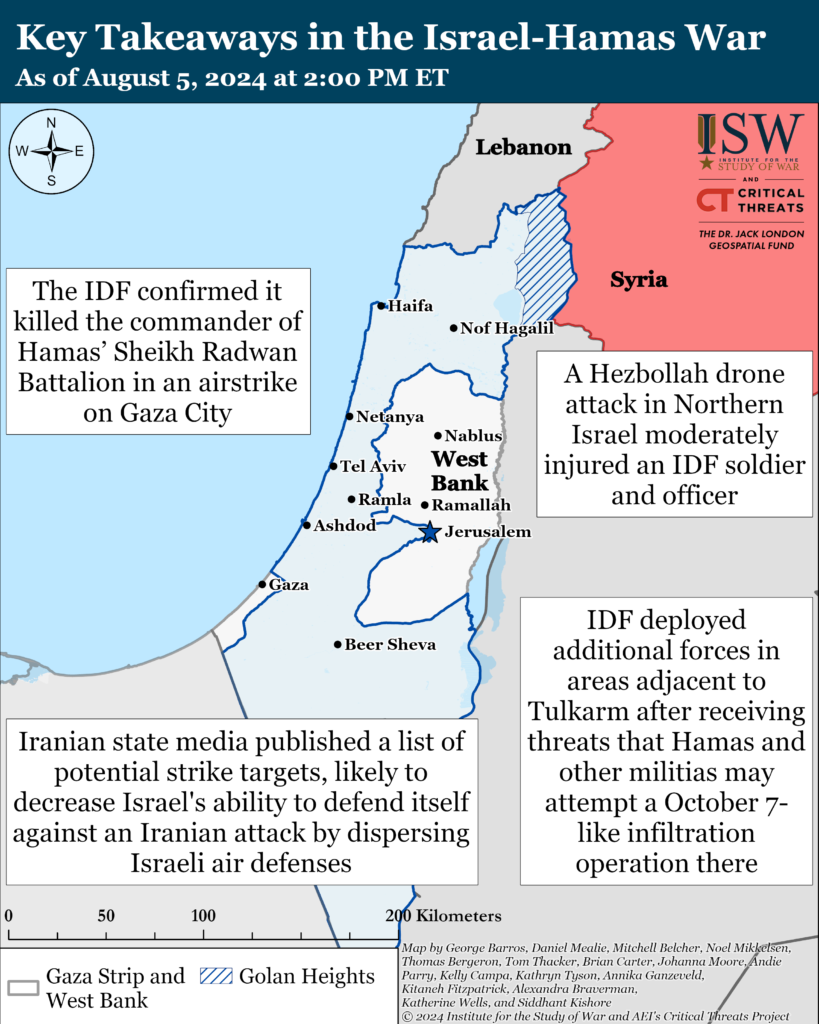
Gaza Strip
Axis of Resistance objectives:
Erode the will of the Israeli political establishment and public to sustain clearing operations in the Gaza Strip
Reestablish Hamas as the governing authority in the Gaza Strip
The IDF Air Force struck and killed the commander of Hamas’ Sheikh Radwan Battalion in Sheikh Radwan, southern Gaza City, on August 4.[61] The Israel Defense Forces (IDF) Air Force struck two Hamas command and control sites in the Hassan Salameh and Nasr schools in Sheikh Radwan on August 4.[62] The IDF Arabic spokesperson confirmed on August 5 that the IDF killed Jaber Aziz, commander of Hamas’ Radwan Battalion, in the strike on the schools.[63] The IDF said that Aziz participated in the October 7 attack and led preparation and training with the Sheikh Radwan Battalion.[64] Aziz previously served as the deputy commander and commander of the Zaytoun Battalion.[65] Aziz had commanded the Sheikh Radwan Battalion since 2020 and previously served as deputy commander.[66] Aziz was reportedly responsible for directing and promoting numerous “terrorist plots” against Israeli forces in the Gaza Strip and in Israeli territory.[67]
The IDF Air Force struck and killed Hamas’ Minister of Economy for the Gaza Strip Abdel Fattah al Zarii in the Gaza Strip on August 4.[68] The IDF said Zarii also worked at the weapons production headquarters of the al Qassem Brigades, Hamas‘ military wing. The al Qassem Brigades’ production headquarters is tasked with improving Hamas’ weapons capabilities through coordination and “exchanging knowledge” with other “terrorist” groups in the Middle East, according to the IDF.[69] The IDF said that Zarii was responsible for distributing fuel, gas, and funds for Hamas’ activities.[70] Zarii also reportedly managed Hamas-controlled markets and Hamas’ takeover of humanitarian aid entry into the Gaza Strip.[71]
Hamas fighters detonated an anti-personnel mine targeting an IDF armored personnel carrier in Tal al Hawa, south of Gaza City, on August 5.[72]
Palestinian militias conducted mortar attacks targeting Israeli forces along the Netzarim Corridor on August 5.[73] Palestinian Islamic Jihad (PIJ) and the al Aqsa Martyrs’ Brigades separately mortared IDF personnel and vehicles along the corridor.[74]
The IDF expanded its evacuation orders to include neighborhoods in central Khan Younis and encouraged Palestinian residents to follow the IDF’s previous evacuation orders for southern Khan Younis and northern Rafah on August 5.[75] The IDF previously issued evacuation orders for southern Khan Younis and northern Rafah on August 4 and said that it would operate in the evacuation zone in the coming days “with force” due to continued rocket attacks from this area.[76] The IDF expanded its evacuation orders slightly north on August 5 to include neighborhoods in central Khan Younis.[77] The IDF Arabic spokesperson told residents that remain within the evacuation zone to leave immediately for al Mawasi humanitarian zone.[78]
Hamas conducted three attacks targeting Israeli forces in the al Faraheen area, east of Khan Younis, on August 5. Hamas detonated an anti-personnel mine targeting Israeli forces positioned in a building in the al Faraheen area in Abasan al Kabira, east of Khan Younis.[79] Hamas also fired small arms and rocket-propelled grenades (RPG) targeting Israeli personnel and armor in the area.[80] A Palestinian journalist reported on August 5 that IDF vehicles advanced into al Faraheen.[81] The IDF has not commented on its presence there as of this writing.
The IDF uncovered a tunnel between Egypt and the Gaza Strip that Palestinian militias used to smuggle large quantities of weapons into the Gaza Strip.[82] The IDF identified a tunnel on August 4 large enough for commercial vehicles to drive through.[83] An Israeli Army Radio correspondent reported that the IDF located railway tracks within tunnels along the Philadelphi Corridor.[84] Smugglers reportedly used the railway tracks to drag wheelbarrows or carts carrying weapons from Egypt into the Gaza Strip.[85] An Israeli military correspondent referred to the tunnel as “the subway of the Philadelphi” Corridor, due to the large scale of smuggling enabled by the tunnels.[86] The IDF has located 30 cross-border tunnels that enabled smuggling along the Philadelphi Corridor and over 100 kilometers of tunnels in Rafah in total.[87] The correspondent reported that the IDF has not found all underground smuggling routes it estimates exist beneath the Philadelphi Corridor and continues to excavate and destroy tunnels.[88] Rafah is home to the most extensive underground tunnel system in the Gaza Strip, according to the IDF.[89] The correspondent noted that Hamas’ Rafah Brigade specializes in tunnel excavation.[90] An unnamed high-ranking Egyptian source denied Israeli reports of active tunnels between the Gaza Strip and Egypt, according to al Qahera News.[91]
Palestinian fighters continued to engage Israeli forces in Rafah on August 5.[92] Three Palestinian militias conducted separate mortar attacks targeting Israeli personnel and vehicles at the Rafah crossing.[93] Hamas fighters detonated three improvised explosive devices targeting Israeli forces in Zalata, east of Rafah.[94]
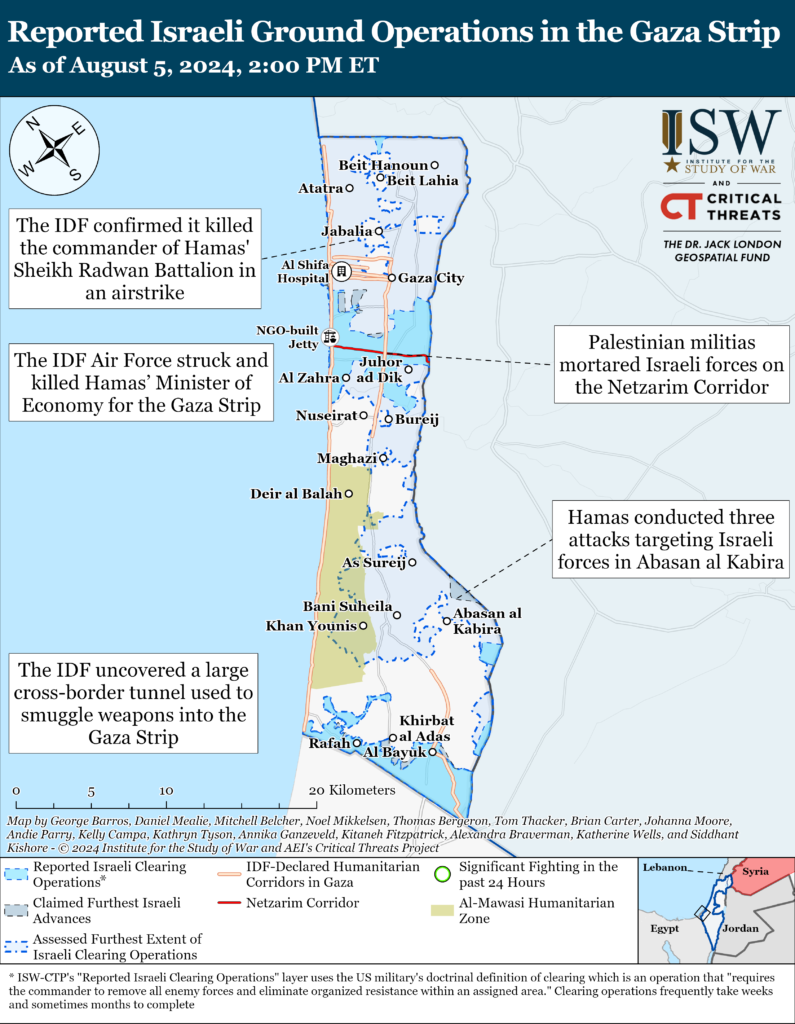
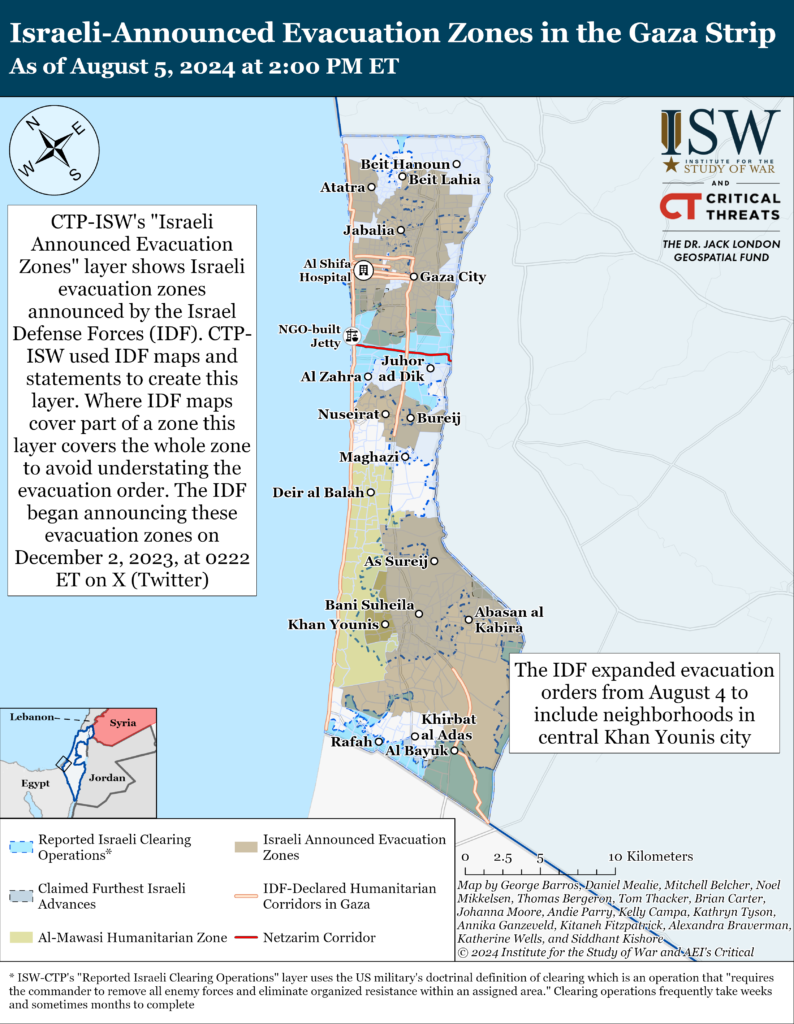
Palestinian militias launched at least 15 rockets from the southern Gaza Strip targeting southern Israel on August 5.[95] The al Aqsa Martyrs’ Brigades fired rockets targeting Kibbutz Re’im and lightly injured a civilian.[96] The Mujahideen Brigades also fired rockets targeting Re’im.[97] The IDF reported that some rockets impacted in Re’im and Gama Junction.[98]
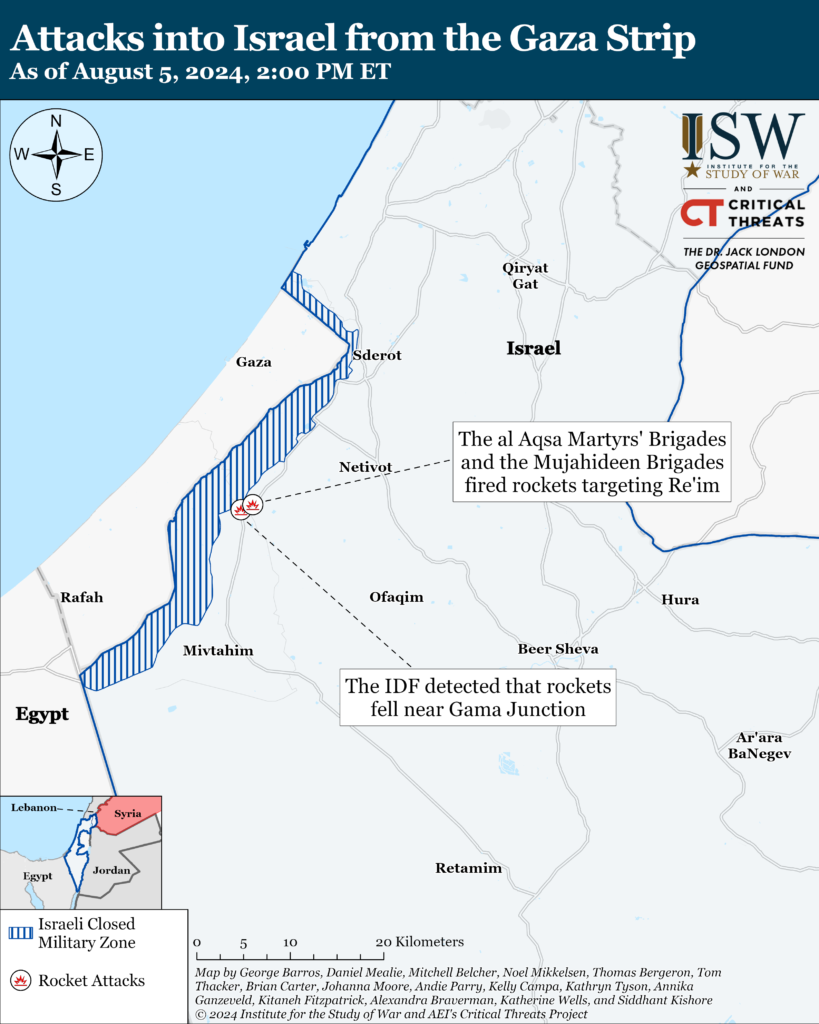
Recorded reports of attacks; CTP-ISW cannot independently verify impact.
Israeli media reported that Israeli Prime Minister Benjamin Netanyahu added a new ceasefire condition that would require all Palestinian fighters released from Israeli prisons to be deported to foreign countries rather than returning to the Gaza Strip or West Bank.[99] Channel 13 reported that the foreign countries would include Turkey and Qatar, citing “sources familiar with the details.”[100] Hamas has not commented upon this reported condition as of this writing.
Hamas officials claimed that Hamas will pick its new leader to replace Ismail Haniyeh in “a matter of days.”[101] Hamas claimed on August 3 that it is conducting wide consultations within its leadership and Shura Council to choose a new movement leader.[102] Hamas Deputy Chairman in the Gaza Strip Khalil al Hayya said in a statement released on August 4 during a press conference in Qatar at Haniyeh’s funeral that Hamas will finish its consultations to choose a new leader in the coming days.[103] Hamas also said that social media and news outlets circulating names of a potential replacement are ”baseless.”[104] Reuters previously reported on July 31 that senior Hamas leader Khaled Meshaal is expected to be chosen as Haniyeh‘s replacement, citing sources in Hamas.[105]
West Bank
Axis of Resistance objectives:
Establish the West Bank as a viable front against Israel
Israeli forces have engaged Palestinian fighters in at least ten locations in the West Bank since CTP-ISW’s last data cut-off on August 4.[106] Palestinian militias including the al Aqsa Martyrs’ Brigades, Palestinian Islamic Jihad (PIJ), and the Mujahideen Brigades engaged Israeli forces in at least eight locations across Jenin Governorate in the West Bank.[107] The al Aqsa Martyrs’ Brigades detonated an improvised explosive device (IED) and fired small arms targeting an IDF vehicle in Jenin.[108] The al Aqsa Martyrs’ Brigades separately targeted Israeli forces in Tulkarm and Nablus, in the West Bank.[109] PIJ fired small arms and detonated IEDs targeting Israeli forces in at least six locations across Jenin.[110]
The IDF reported that unspecified individuals fired small arms in Beka’ot settlement in Jordan Valley, West Bank, on August 5.[111] The IDF claimed that there were no casualties. The IDF launched a search operation in the area following the shooting.[112]
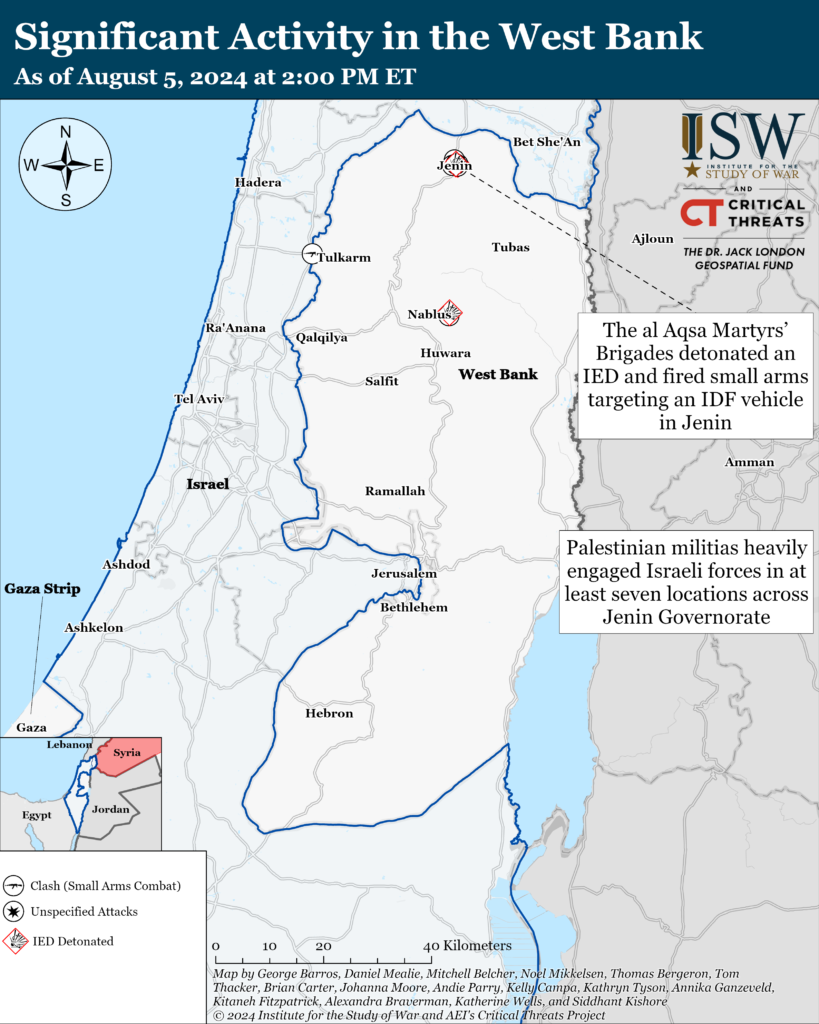
This map is not an exhaustive depiction of clashes and demonstrations in the West Bank.
Southern Lebanon and Golan Heights
Axis of Resistance objectives:
Deter Israel from conducting a ground operation into Lebanon
Prepare for an expanded and protracted conflict with Israel in the near term
Expel the United States from Syria
Iranian-backed militias, including Lebanese Hezbollah, have conducted at least 10 attacks into northern Israel since CTP-ISW’s last data cut-off on August 4.[113] Hezbollah launched a drone wave targeting the barracks of the IDF 91st division in Ayelet HaShahar on August 5.[114] The IDF attempted to intercept “suspicious aerial targets it identified,” but did not confirm if the interceptors successfully shot down the drones. One drone struck near Ayelet HaShahar, moderately injuring an IDF soldier and officer.[115] The attack also started a small fire in the area.[116] Hezbollah claimed the attack, adding that the attack was in response to previous Israeli strikes.[117]
A separate Hezbollah drone attack targeting an unidentified site in Malkia, northern Israel, on August 5 crossed into Israel despite IDF detection and fell on Malkia. The attack caused no casualties.[118] The IDF detected two unclaimed drone attacks likely launched by Hezbollah on August 5. The IDF intercepted one drone over Western Galilee and another drone over Metula.[119]
Local Syrian media reported that an Israeli airstrike injured the head of Hezbollah’s drone unit at Dabaa military airport in Homs Province, Syria.[120] CTP-ISW previously reported that the IDF reportedly struck Dabaa military airport on August 2.[121] Syrian media reported on August 4 that Hussein Burji, the head of Hezbollah’s drone unit, was critically injured in a hangar at Dabaa airport.[122] Burji reportedly assumed his command of Hezbollah‘s drone unit after Israel killed the former Hezbollah Air Force commander and Burji’s brother, Ali Burji, at a Radwan commander’s funeral in January 2024.[123] Dabaa Airport notably facilitates Iranian weapons shipments for Hezbollah.[124]
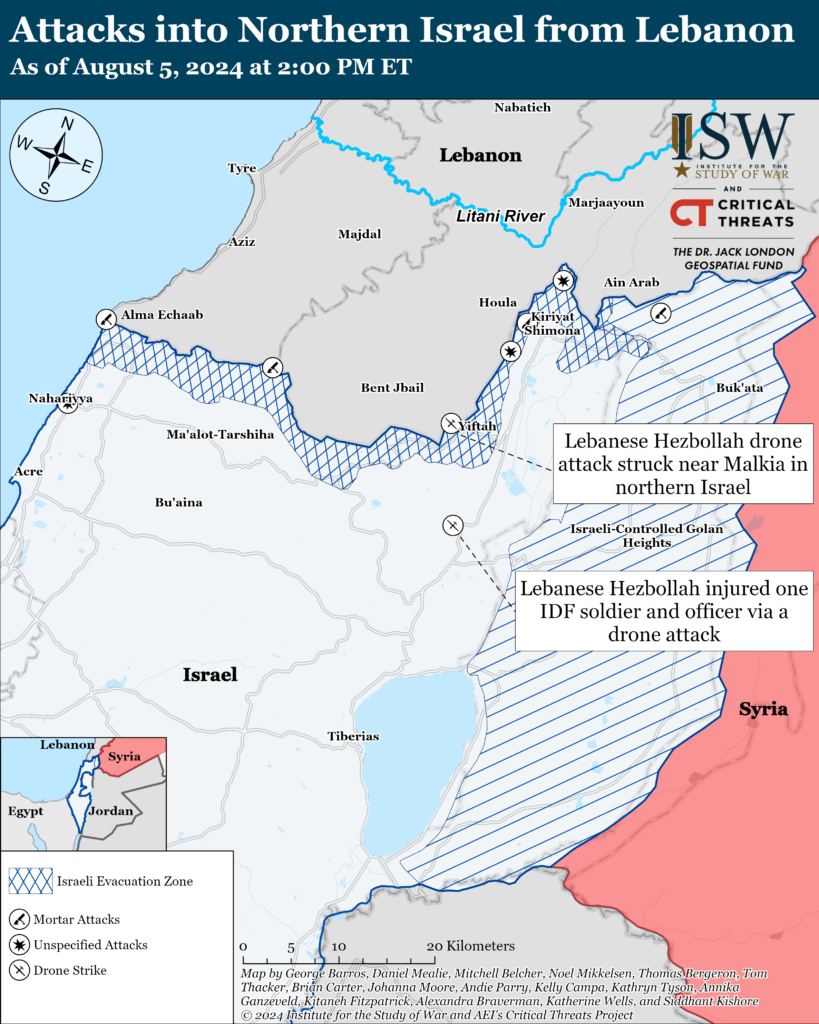
Iran and the Axis of Resistance
Iranian-backed Iraqi parliamentarians issued separate statements criticizing the US and the Iraqi Federal Government for failing to produce a timeline for the withdrawal of US forces from Iraq on August 4.[125] Ali Turki, a member of Asaib Ahl al Haq’s Sadiqoun Bloc in parliament, claimed that US officials have stalled withdrawal negotiations and have not agreed to an immediate or scheduled withdrawal.[126] Badr Organization member of parliament Mahdi Taqi separately demanded that the Iraqi federal government set a date for the expulsion of US and foreign forces.[127] Taqi noted that the Iraqi parliament passed a law to expel US forces, likely a reference to the 2020 non-binding resolution that requested the Iraqi federal government cancel the US-led international coalition’s anti-ISIS mission in Iraq.[128] The resolution is non-binding because US forces in Iraq are there under an executive agreement, meaning that only the prime minister can decide to expel them.[129]
US Secretary of State Anthony Blinken spoke with Iraqi Prime Minister Mohammed Shia al Sudani to discuss regional security developments and ongoing US-Iraq Higher Military Commission negotiations on August 4.[130] The Higher Military Commission, which is comprised of US and Iraqi military officials, began evaluating the status of the US-led international coalition in Iraq in late January 2024 and most recently met in Washington, DC, on July 23.[131] The US Department of State emphasized the importance of protecting US forces in Iraq while the Higher Military Commission continued negotiations and determines how the US-led coalition will transition to bilateral US-Iraqi relations.[132]
Syrian opposition media reported on August 4 that Iranian-backed militias instructed the Fatemiyoun militia to move materiel towards the Euphrates River ahead of Iranian-backed militia attacks on US forces in Syria.[133] Syrian opposition outlet Euphrates Post reported that Iranian-backed militia leaders instructed Fatemiyoun—a Shia Afghan Iranian-backed militia—to withdraw from the Central Syrian Desert and move forces and materiel towards the Albu Kamal countryside in preparation for militia attacks that will “target the coalition” positions at al Omar oil field, Conoco Mission Support Site, and al Tanak oil fields.[134] The report did not specify which militias would conduct the attacks against US forces. Fatemiyoun commander Abdul Baqir Alawi reportedly also ordered the transfer of “heavy weapons” that are “believed to contain medium-range missiles and drones” to the Albu Kamal countryside.[135] CTP-ISW previously assessed that Iran and its Axis of Resistance may target US forces in Syria as part of a retaliatory strike for Israel killing several Axis of Resistance leaders.[136] CTP-ISW cannot verify this local reporting, however.
Iranian Acting Foreign Affairs Minister Ali Bagheri Kani continued to discuss regional tensions in phone calls with several other foreign ministers on August 4 and 5.[137] Bagheri Kani claimed that Israel violated international law, adding that Iran had a “right” to defend “its security, sovereignty and territorial integrity” in his call with Slovenian Foreign Minister Tanja Fajon on August 4.[138] Bagheri Kani also spoke to Bahraini Foreign Minister Abdullatif bin Rashid al Zayani on August 5 and stressed that any silence surrounding “Israel’s evils” is a detriment to peace in the region.[139] Zayani and Fajon reiterated their support for a ceasefire in the Israel-Hamas war.
 Eurasia Press & News
Eurasia Press & News
